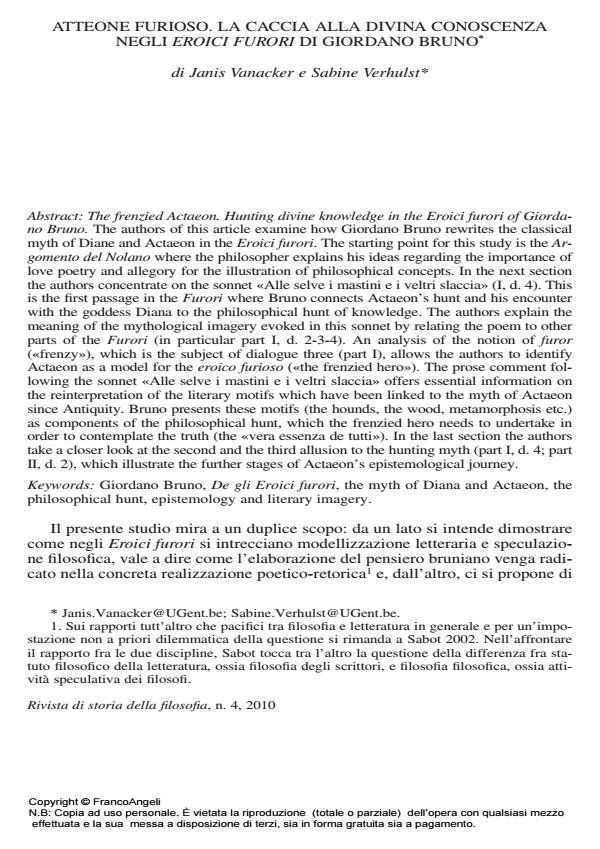Atteone furioso. la caccia alla divina conoscenza negli Eroici furori di Giordano Bruno
Titolo Rivista RIVISTA DI STORIA DELLA FILOSOFIA
Autori/Curatori Janis Vanacker, Sabine Verhulst
Anno di pubblicazione 2010 Fascicolo 2010/4
Lingua Italiano Numero pagine 23 P. 695-717 Dimensione file 720 KB
DOI 10.3280/SF2010-004003
Il DOI è il codice a barre della proprietà intellettuale: per saperne di più
clicca qui
Qui sotto puoi vedere in anteprima la prima pagina di questo articolo.
Se questo articolo ti interessa, lo puoi acquistare (e scaricare in formato pdf) seguendo le facili indicazioni per acquistare il download credit. Acquista Download Credits per scaricare questo Articolo in formato PDF

FrancoAngeli è membro della Publishers International Linking Association, Inc (PILA)associazione indipendente e non profit per facilitare (attraverso i servizi tecnologici implementati da CrossRef.org) l’accesso degli studiosi ai contenuti digitali nelle pubblicazioni professionali e scientifiche
The authors of this article examine how Giordano Bruno rewrites the classical myth of Diane and Actaeon in the Eroici furori . The starting point for this study is the Argomento del Nolano where the philosopher explains his ideas regarding the importance of love poetry and allegory for the illustration of philosophical concepts. In the next section the authors concentrate on the sonnet «Alle selve i mastini e i veltri slaccia» (I, d. 4). This is the first passage in the Furori where Bruno connects Actaeon’s hunt and his encounter with the goddess Diana to the philosophical hunt of knowledge. The authors explain the meaning of the mythological imagery evoked in this sonnet by relating the poem to other parts of the Furori (in particular part I, d. 2-3-4). An analysis of the notion of furor («frenzy»), which is the subject of dialogue three (part I), allows the authors to identify Actaeon as a model for the eroico furioso («the frenzied hero»). The prose comment following the sonnet «Alle selve i mastini e i veltri slaccia» offers essential information on the reinterpretation of the literary motifs which have been linked to the myth of Actaeon since Antiquity. Bruno presents these motifs (the hounds, the wood, metamorphosis etc.) as components of the philosophical hunt, which the frenzied hero needs to undertake in order to contemplate the truth (the «vera essenza de tutti»). In the last section the authors take a closer look at the second and the third allusion to the hunting myth (part I, d. 4; part II, d. 2), which illustrate the further stages of Actaeon’s epistemological journey.
Parole chiave:Giordano Bruno, <i>Degli Eroici furori </i>, the myth of Diana and Actaeon, the philosophical hunt, epistemology and literary imagery
- Liberty, Irreverence, and the Place of Women in Early Modern Italian Culture: Essays in Honour of Letizia Panizza Stephen Clucas, pp.151 (ISBN:978-3-031-72297-4)
- Hunting Troubles Olaf Berwald, pp.185 (ISBN:978-3-031-70222-8)
Janis Vanacker, Sabine Verhulst, Atteone furioso. la caccia alla divina conoscenza negli <i> Eroici furori</i> di Giordano Bruno in "RIVISTA DI STORIA DELLA FILOSOFIA" 4/2010, pp 695-717, DOI: 10.3280/SF2010-004003